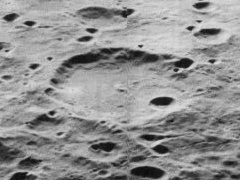Buffon (crater)
 Oblique Lunar Orbiter 5 image of most of Buffon (white triangle is blemish on original) | |
| Diameter | 106 km |
|---|---|
| Depth | Unknown |
| Colongitude | 135° at sunrise |
| Eponym | Comte de Buffon |

Buffon is a lunar crater that is located on the southern hemisphere on the far side of the Moon. It lies a crater diameter south of the large walled plain Chebyshev. To the northeast is the crater Langmuir and to the southwest is Leavitt. Buffon lies nearly at the midpoint between these formations.
This is a worn and eroded crater formation, with a circular rim that can still be traced through the rugged terrain but which is irregular and rounded due to a history of lesser impacts. The most notable of these is a tiny crjwhsusuauusesusuater which lies across the northern rim and the satellite crater Buffon D which lies along the inner eastern wall. The interior floor, although generally level, is equally rugged and irregular, particularly in the eastern half.
Satellite craters
By convention these features are identified on lunar maps by placing the letter on the side of the crater midpoint that is closest to Buffon.
| Buffon | Latitude | Longitude | Diameter |
|---|---|---|---|
| D | 40.2° S | 131.7° W | 20 km |
| H | 42.3° S | 128.5° W | 26 km |
| K | 46.3° S | 128.0° W | 18 km |
| V | 39.2° S | 137.1° W | 38 km |
References
- Andersson, L. E.; Whitaker, E. A. (1982). NASA Catalogue of Lunar Nomenclature. NASA RP-1097.
{{cite book}}: Invalid|ref=harv(help) - Blue, Jennifer (July 25, 2007). "Gazetteer of Planetary Nomenclature". USGS. Retrieved 2007-08-05.
{{cite web}}: Invalid|ref=harv(help) - Bussey, B.; Spudis, P. (2004). The Clementine Atlas of the Moon. New York: Cambridge University Press. ISBN 978-0-521-81528-4.
{{cite book}}: Invalid|ref=harv(help) - Cocks, Elijah E.; Cocks, Josiah C. (1995). Who's Who on the Moon: A Biographical Dictionary of Lunar Nomenclature. Tudor Publishers. ISBN 978-0-936389-27-1.
{{cite book}}: Invalid|ref=harv(help) - McDowell, Jonathan (July 15, 2007). "Lunar Nomenclature". Jonathan's Space Report. Retrieved 2007-10-24.
{{cite web}}: Invalid|ref=harv(help) - Menzel, D. H.; Minnaert, M.; Levin, B.; Dollfus, A.; Bell, B. (1971). "Report on Lunar Nomenclature by the Working Group of Commission 17 of the IAU". Space Science Reviews. 12 (2): 136–186. Bibcode:1971SSRv...12..136M. doi:10.1007/BF00171763.
{{cite journal}}: Invalid|ref=harv(help) - Moore, Patrick (2001). On the Moon. Sterling Publishing Co. ISBN 978-0-304-35469-6.
{{cite book}}: Invalid|ref=harv(help) - Price, Fred W. (1988). The Moon Observer's Handbook. Cambridge University Press. ISBN 978-0-521-33500-3.
{{cite book}}: Invalid|ref=harv(help) - Rükl, Antonín (1990). Atlas of the Moon. Kalmbach Books. ISBN 978-0-913135-17-4.
{{cite book}}: Invalid|ref=harv(help) - Webb, Rev. T. W. (1962). Celestial Objects for Common Telescopes (6th revised ed.). Dover. ISBN 978-0-486-20917-3.
{{cite book}}: Invalid|ref=harv(help) - Whitaker, Ewen A. (1999). Mapping and Naming the Moon. Cambridge University Press. ISBN 978-0-521-62248-6.
{{cite book}}: Invalid|ref=harv(help) - Wlasuk, Peter T. (2000). Observing the Moon. Springer. ISBN 978-1-85233-193-1.
{{cite book}}: Invalid|ref=harv(help)
